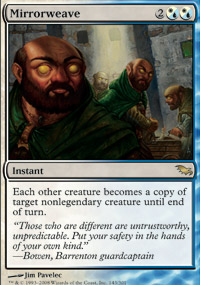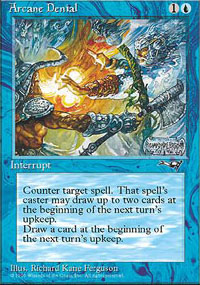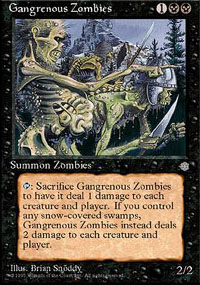
Ask the Goyf
By Eli Shiffrin, Brian Paskoff, and Aaron Stevenson
By Eli Shiffrin, Brian Paskoff, and Aaron Stevenson
Hey hey! It's me, Brian Paskoff again. Sorry to drop in all unexpected, but we're currently dealing with a strange schedule now that it's just me and Eli until we break in the new guy. Aaron's first article will be next week, and then we're back on some sort of solid schedule just in time for the holidays! It's everything I always wanted! Well, actually what I really want for the holidays is more questions into the Cranial Insertion mailbag, so send 'em in!
On another note, I want to thank the great judges at starcitygames.com for writing the Ask the Judge column for so long. The column was recently discontinued for a few reasons I won't get into here, because the reasons for it going away aren't as important as the contributions the column made to the Magic community, both players and judges alike...including yours truly, who used AtJ as a great study tool (along with Cranial Insertion) on the way to becoming a judge. So thank you, Chris Richter, Seamus Campbell, Nick Fang, Johanna Virtanen, and all the other judges who contributed over the years!

Not you again!
A: It will! The two damage on the land doesn't disappear; it just rarely matters how much damage is on an unanimated land. During the cleanup step, both Mirrorweave and the damage will wear off, so after that you're clear to reanimate your Treetop Village.
Q: If I have animated basic lands in play, do they get the bonus from Muraganda Petroglyphs?
A: There's a whole lot more creatures that don't benefit from Muraganda Petroglyphs than most people realize. Any text in a card's text box is an ability, and that disqualifies them from the +2/+2 bonus. But wait, those newfangled basic lands don't have text in their text box, just a big mana symbol, right? Well if you look at a basic land reaaaal closely, you'll see some tiny text...no, just kidding, it's a lot more boring than that:
[...] A land with a basic land type has an intrinsic ability to produce colored mana. (See rule 406, "Mana Abilities.") The land is treated as if its text box included, "{T}: Add [mana symbol] to your mana pool," even if the text box doesn't actually contain text or the card has no text box.
Of course, even a Grizzly Bears loses its Petroglyphs bonus if something gives it an ability, so the "text = no +2/+2" thing doesn't always apply.
Q: If I kill a Sower of Temptation that's stolen my Chameleon Colossus, can I attack with the Colossus that turn?
A: Even though the Colossus has been in play for more than a turn, a creature without haste can't attack unless it's been under your control since the beginning of your turn.
Q: I play an Oblivion Ring and say I'm going to remove my opponent's Mogg Fanatic. If he sacrifices it in response to me playing the O-Ring, can I counter my own Ring instead of removing something else...say if the only other non-land permanents in play are ones I control?
A: We've gotten a few replies to Eli's question last week, and it appears there's some confusion over priority and the stack. Both players need to pass priority in succession for the top object of the stack to resolve. So if you play Oblivion Ring, and your opponent activates his Mogg Fanatic, both of you get a chance to do something both before Mogg Fanatic's ability resolves and immediately after it resolves - because Oblivion Ring is now the top object on the stack. That's your last chance to do something about your own spell gone haywire.

How to say "No" and still
be civil about it.
A: A long time ago, Wizards decided that slow-trips ("draw a card at the beginning of the next turn's upkeep") weren't printable anymore. They were mandatory triggers with a whole turn passing before they went on the stack, and players didn't like the memory issues involved with them. These days, newer cards are printed with the simple phrase "draw a card", but the old ones such as Arcane Denial are stuck waiting for the next turn's upkeep. Wizards did print five slow-trips in the nostalgia-themed Coldsnap set though, which should show you that the ability isn't dead...just outdated.
Q: Does Empyrial Archangel have shroud in the graveyard?
A: Empyrial Archangel has shroud no matter where it is. However, like most abilities, shroud only functions while the Archangel is in play...so it can be targeted with reanimation spells just fine.
Q: If I play a Vesuvan Shapeshifter copying a Figure of Destiny, then pump it up to a 4/4 and flip it face down on my next upkeep, what's it look like?
A: It'll be a face-down creature alright, but it'll still be a 4/4. The continuous effects generated by those activated abilities apply in later layers than morph, so it'll keep all the Figure of Destiny-applied stuff.
Q: As long as players are able to gain life, is Wall of Shards's cumulative upkeep optional?
A: Paying for a card's cumulative upkeep is always optional. Even though the card's reminder text doesn't say it, cumulative upkeep means "At the beginning of your upkeep, put an age counter on this permanent. Then you may pay [cost] for each age counter on it. If you don’t, sacrifice it." If players can't gain life for some reason, then you can't pay Wall of Shards's cumulative upkeep.
Q: If I control a Death Match and a Troll Ascetic, can my opponent kill my Troll when he plays a creature?
A: Even though your opponent is making the choices, you still control the triggered ability, so he'll be able to pick the Troll as the target for it.
Q: My opponent has a Magus of the Abyss out and I have a Mutavault in play. At the beginning of my upkeep, can I animate the Mutavault and have the Magus kill it?
A: At the beginning of your upkeep, Magus of the Abyss's triggered ability triggers and goes onto the stack, and those player whose upkeep it is (yours) chooses a target for the ability. This all happens before anyone gets priority, so you have to choose a legal target that's already in play. Mutavault won't be a creature at this time, so it's not a legal target. If Magus's ability was written "At the beginning of each player's upkeep, that player sacrifices a nonartifact creature," then you could, since there'd be no target required and it'd make you lose a creature when the ability resolved, not when it was put onto the stack.
Q: I attacked with a Wren's Run Vanquisher that had a +1/+1 counter and trample from my Bramblewood Paragon and my opponent blocked with a Mulldrifter. When damage resolved, my opponent tried to say that since I didn't assign trample damage to him, all of it was assigned to the creature. What happens?
A: There's shortcut guidelines for this sort of thing in tournament policy. One of the well established shortcuts is that the default for assigning trample damage is that the trampling creature assigns enough combat damage to kill all blockers, and the remainder to the defending player. So there's no way to rules-lawyer yourself out of taking trample damage!
Q: It's my untap step and my Hollowsage untaps, as it usually does. My opponent and I have an equal number of cards in our hands. Will he discard the card so my Akuta, Born of Ash can trigger at the beginning of my upkeep?
A: While Hollowsage's triggered ability triggers during your untap step, triggered abilities don't actually go onto the stack until a player would gain priority, and no one gets priority during the untap step. The first time in a turn anyone does get priority is at the beginning of your upkeep, and by that time it's too late for Akuta's ability to trigger.
Q: How does Root Maze interact with shocklands like Temple Garden? If I pay two life, will the shockland come into play untapped?
A: You can pay two life if you want, but it won't change how Temple Garden comes into play. There are two replacement effects affecting how Temple Garden comes into play, itself and Root Maze. Since you're the controller of the affected permanent, you choose which one applies first... but in the end, it doesn't matter, since shocklands don't say they come into play untapped if you pay two life, so Root Maze will make it come into play tapped either way.

Old activated ability wording is old!
A: Gangrenous Zombies has deathtouch while it's in play, but not while it's in the graveyard...and it's in the graveyard when it deals damage to everything.
Q: If I have a Capsize underneath a Shelldock Isle, can I pay its buyback cost when I play it so that it goes back to my hand when it resolves?
A: That'll work! Buyback is an additional cost to play the spell, and although hideaway forces you to pay the alternate cost of not paying the spell's mana cost, you're still allowed to play additional costs suck as buyback and kicker.
Q: At the end of my turn, I don't control any creatures with power 5 or greater. With Drumhunter's trigger on the stack, can I Nameless Inversion a Sprouting Thrinax so I draw a card?
A: That won't work. Drumhunter's trigger has an "intervening if" clause, so it won't even trigger if its trigger condition isn't true. If you had a creature that would survive Nameless Inversion while getting its power bumped up to the magic number, you could Inversion it before the end of turn step so it'll be a 5(plus?)/X creature when "at end of turn" triggers trigger.
Q: If I use Mirrorweave to make everything in play a copy of something with persist, such as Kitchen Finks, and then Wrath of God, what happens to all the creatures?
A: When they hit the graveyard, the game will sort of "look back in time" to see if anything relevant should trigger. It'll see that as these creatures last existed, they had persist, so persist will trigger and bring them all back into play with a -1/-1 counter on them. They won't be Kitchen Finks anymore, just their usual selves...only with -1/-1 counters on them.
Q: If I play a Goldmeadow Stalwart from underneath a Windbrisk Heights, do I need to show a Kithkin or pay ?
A: Even though hideaway lets you play the spell without paying its mana cost, you'll still need to pay any additional costs, so show your opponent one of the Stalwart's friends or pay up!
Q: If I doodle on the face of my cards with a sharpie, can I still play them in sanctioned tournaments?
A: Cards aren't allowed to have writing on them other than signatures and artistic modifications, which covers pretty much everything. You can't obscure the artwork of the card to make it unrecognizable, since that's what most players and judges use to identify cards. If you're writing notes on the card (such as "sideboard this out against Faeries"), that's illegal - and don't write or draw anything obscene on the card, as that could constitute unsporting conduct.
The final answer of what's allowed on the card is always up to the head judge, so it's best to ask the head judge of your tournament if he or she thinks your artistically modified card is alright to play.
Q: In a game of Elder Dragon Highlander, I Oblivion Ringed someone's general. Can they play their general again even if it was removed with Oblivion Ring? If so, what happens when the O-Ring leaves play and the general isn't there...and what if it's left the RFG zone and come back a few times since?
A: It seems I'm the resident EDH expert, so I'll take this one. Rule #9 (isn't it nice to see rules without three digits and a decimal point and maybe a letter tacked on the end?) of the EDH rules says, "While a General is removed from the game, it may be played. As an additional cost to play your General this way, you must pay {2} for each previous time you have played it this way." This rule doesn't stipulate how it was removed from the game, just that it is in the removed from game zone. If it's played again and Oblivion Ring leaves play later on, nothing will happen, as O-Ring's trigger can't find it in that zone anymore. Even if the general had returned to play and removed from the game again by the time O-Ring's finally left play, the trigger still won't do anything - an object that changes zones is considered a new object. (See rule 410.10. Sorry, back to the decimal system.)
Well that's it for me this week! If I don't see you before then, have a happy holidays!
Comments